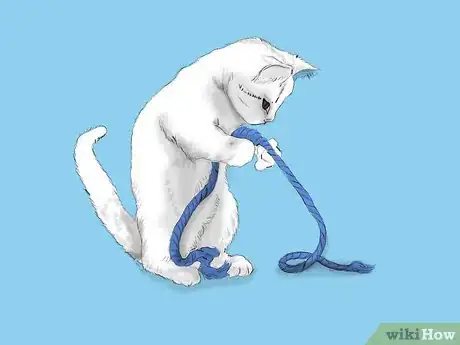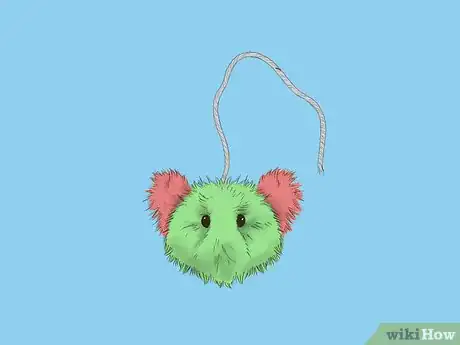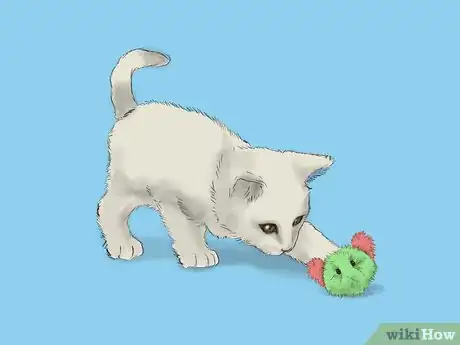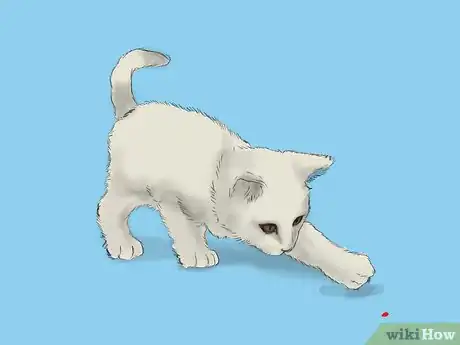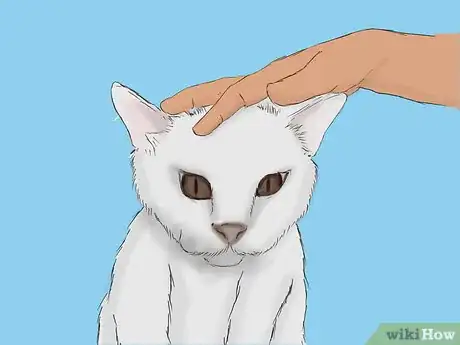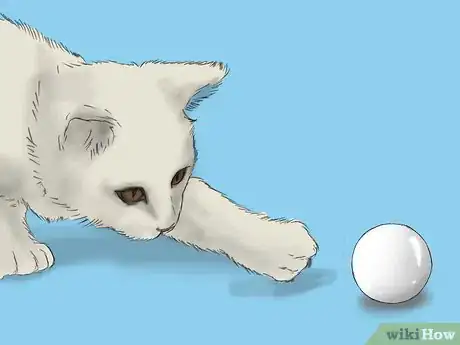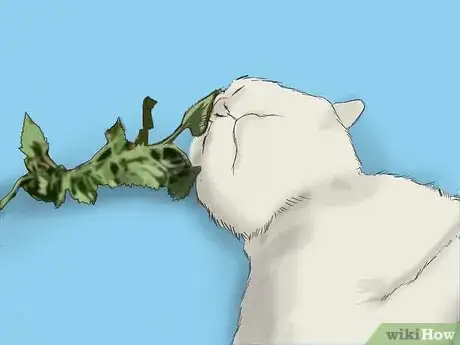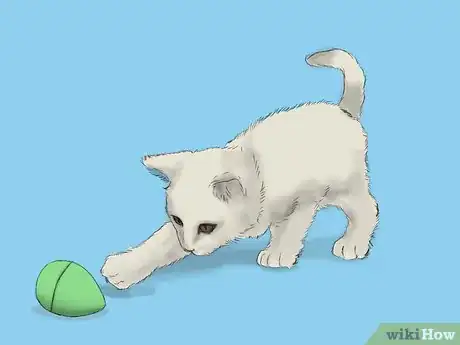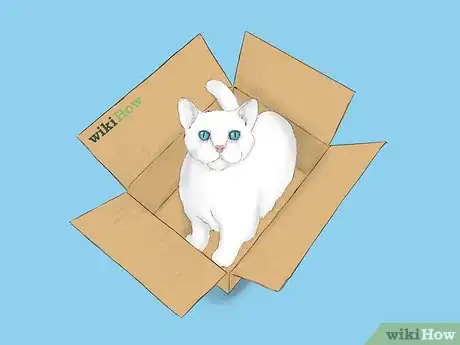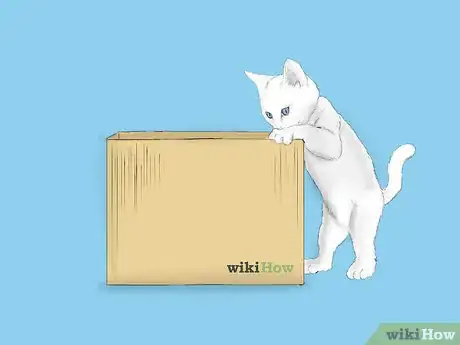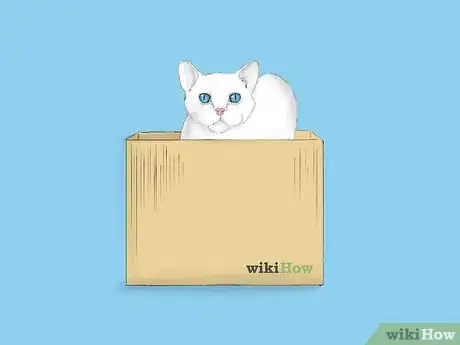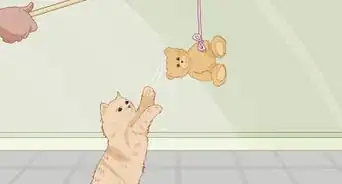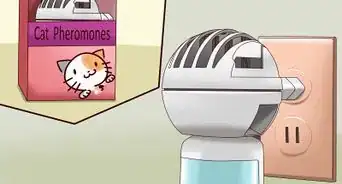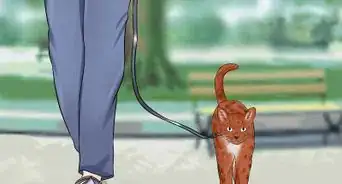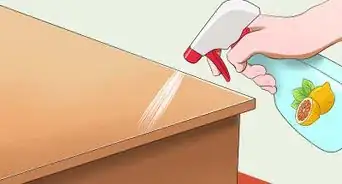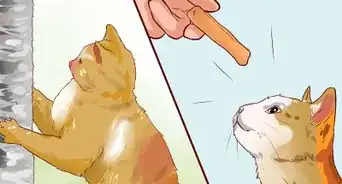This article was co-authored by Jessica Char. Jessica Char is a Cat and Dog Trainer, Behavior Consultant, and the Founder of Feline Engineering and Canine Engineering. She specializes in modifying challenging pet behavior problems, such as fear and aggression, using positive reinforcement training protocols. Jessica is a Certified Fear Free Trainer, a Certified Professional Dog Trainer, and a Certified Separation Anxiety Trainer. She is also a member of the International Association of Animal Behavior Consultants. Jessica received her BS and MS in Biomedical Engineering from Washington University in St. Louis.
This article has been viewed 79,532 times.
Domestic cats, especially young kittens, are known for their love of play. This behavior mimics hunting and is important in helping kittens learn to stalk, capture, and kill prey. Cats also engage in play fighting, with each other and with humans. This behavior is a way for cats to practice the skills they need for hunting and combat, and it might also reduce any fear that they associate with launching attacks on other animals.
Steps
Using a String and a Toy
-
1Activate your cat's natural hunting instinct. Get your cat to stalk a rope, a wind-up toy, or a fluffy or feathered toy tied to a string.[1] A piece of string with something fluffy attached to it is one of the simplest toys that you can make, and it is also one of the most effective. Use an old stuffed animal that you don't mind letting a cat chew on. Try to find objects that are smaller than your cat, roughly the size of its natural prey (small birds and rodents). If you don't have a stuffed animal, you can just drag a string around — there's a good chance that your cat will still try to "hunt" the end of the string.
- It helps when a toy makes some kind of sound to grab your cat's attention, whether it squeaks, rattles, or clicks. Cats have very good hearing, so even a piece of rope sliding over the floor may be enough sound to grab their attention.
- For cats, playing also functions as training for hunting skills. Play and hunting often go hand-in-hand, and cats will use their claws to bat at anything that holds their attention.
- It is very easy for a cat to use its imagination, but you need to activate it sometimes. A piece of rope lying limply by itself isn't a prey-like toy. However, when you grab that rope and pull it away from your cat, it will trigger your cat into hunting for its prey.
- These toys mimic the motion of birds flying in the air, which cats love to chase after.[2]
-
2Tie a string to the toy. Tie a noose into a length of twine and loop the noose around the toy's neck. You can also tie the string to the toy's tail, midriff, or leg — anything that allows you to jiggle the toy in a lifelike manner.
- Make sure that once you've tied the toy, it can stand up on its own. A floppy old stuffed animal won't fool your cat for long. It needs to be able to stand!
Advertisement -
3Tie the twine onto a stick. You can simply hold the string in your hand to make the toy move, but an extra degree of separation between your hand and the stuffed animal may help your cat forget that you are the one dangling the toy. Tie the free end of the twine onto a sturdy but comfortable stick.
-
4Tease your cat. Get your cat's attention by dangling the stuffed animal on its string so that the cat cannot ignore it, and then make your stuffed animal stand still, upright, facing your cat. Wait for your cat to pounce on the stuffed animal, then pull it away. Try to entertain him by both letting him grab the string, and by letting him almost grab the string. Make the game difficult, but make it possible to "win".[3] The important thing is that you catch your cat's attention with a sudden motion, then keep the toy still enough to give your cat the chance to "stalk" its prey.
- When cats put their nails into something, they don't want to let go. This is where the fun begins. Once they grab their 'prey' it is your job to make the 'prey' to try to escape from his claws by both alternating between gentle and rude pulling on the rope.
- Make your cat run around! Guide him with the toy. Make the cat use your furniture as an obstacle, and jump in the air as high as possible. Make your cat run in circles.
- If you practice this kind of play with your cat often enough, the cat might hold onto the piece of string so fiercely that you can drag him around.
-
5Let cats play when they want to. Give your cat the chance to suss out the situation, and do not interrupt. When the is ready to pounce, it will happen. When the cat is done playing, it will stop. Try not to look at your cat while "fighting" with a toy, and do not hit or push to play with a certain toy.
Using Other Methods
-
1Use a laser pointer to tease your cat. Point the laser at the ground or the wall near your cat.[4] Move the laser to catch your cat's eye, then keep it still for a moment to build suspense. Move the laser around, slowly, and your cat may begin to stalk it like prey. Do not move the laser around too rapidly, or your cat may lose spirit. Just when your cat pounces onto the laser, move it quickly away.
- You can find laser pointers online, at pet-supply stores and at most technology stores.
- Be careful not to point the laser into your cat's eyes. Once you have your cat under the spell of the laser, try not to lead it anywhere dangerous. Cats may run headlong into a chair or wall because they are so focused on the dot.[5]
- Give your cat treats after he's played with the laser pointer. This way, your cat will feel like he's "caught" his dinner.[6]
-
2Throw paper or wrappers. Use materials that will make enough noise to catch your cat's attention, but not so much noise to scare your cat away. Ball up the paper, wave it slowly until your cat is tracking it with his eyes, and then throw it a short distance for your cat to chase. This may also work with food or toys.
-
3Use your hand to play-fight. Gently "wrestle" with your cat as though your hand were another cat. Let the cat rub its head against your hand, and let it bat your hand with its hand. Be wary: a cat won't usually use its claws while play-fighting, but it might nibble or bite your hand.
- Avoid using both hands when playing, as the cat will feel outnumbered and flee. This is, incidentally, a good way of ridding yourself of a playful cat when you're no longer in the mood.
-
4Use a plain ping-pong ball. This might sound boring to you, but many cats love to swat and play with them. Roll the ball gently toward or past your cat to get some attention. If the cat's eyes track the motion of the ball, it means that he sees the ball as potential "prey." Some older cats may not bother to move if you throw the ball.
-
5Use catnip. You can give your cat a sprig of fresh or dried catnip, or you can buy a catnip toy for your cat to play with.[7] Many cats love the smell of catnip, and some cats become visibly intoxicated by it. They may stare into space, stumble around, and roll on the floor in pleasure.
- Be warned that every cat reacts differently to catnip.[8] Your cat may love it, your cat may indifferent, and your cat may even abuse the stuff. Give your cat small amounts of catnip, and watch it for cues.
- You may also consider buying catnip spray from a pet store and spraying it onto the toys that your cat already has. Spray the catnip spray onto the toys and wait for it to dry. Once it has fully dried, slowly bring out the toys.
-
6Use a plastic egg filled with rice. You can fill a surprise egg or plastic Easter egg with rice and use it to play with your cat. You can even make a little hole on one end of the egg, and pull a thread through it, and make a knot in the thread. The sound of the rice shaking may draw your cat's attention, and the string will help you make the egg seem as though it is moving of its own volition.
-
7Brush your cat with an animal brush. You can brush their chins, their tails and backs, as well as their bellies. Brush under the tail and on either side, but don't brush your cat's butt. Test it out on your cat, but be aware that not all cats like being brushed. Cats may be wary about you touching their bellies. Don't brush too hard, or else the bristles might hurt your cat.
Giving Your Cat a Box or Bag
-
1Let your cat play in a box or a bag. If you don't have any spare time to play with your cats, a cardboard box or a shopping bag will provide endless entertainment.[9] Cats might be predators in their natural habitat, but they are not the highest in the food chain, and they love to hide out in small spaces.[10]
- A box should be large enough for the cat to climb inside, but not so tall that your cat cannot climb out afterward. You can set it upright or on its side, as long as the cat can easily access it.
- You can use any type of bag that your cat fits inside, but be wary of plastic bags that can trap and suffocate your cat. In general, paper and canvas bags are safer and more breathe-able.
-
2Set the box or bag out where your cat will find it. Make sure to use a space in which your cat is comfortable: a living room, a bedroom, or any place where your cat spends much of its time. Try putting a treat, a toy, or a sprig of catnip into the container to entice your cat inside. Try putting crinkly, noisy paper into the box to give your cat something to explore.
-
3Let your cat use the box or bag on his own terms. You can pick the cat up and put him into the box, but do not force him back in if he climbs out. Avoid tipping the box or bag over while the cat is inside, or else you may give your cat scary associations with the space. Your cat may spend hours at a time resting in the box, and it may become a place that he associates with safety.
- Never make your cat feel as though he is trapped or cornered. Avoid reaching into the box or looming over the exit, especially if your cat tends to be skittish.
-
4Respect your cat's space. Some cats love to hide out in cupboards and drawers, under beds and blankets, or perched on the tops of furniture and cat trees. Your cat may enjoy a box or bag that you set out, but it may revert to its own "safe spaces".
Community Q&A
-
QuestionI got a laser pointer for Xmas and I want to play with my cat, but how often should I?
 Community AnswerUse a laser pointer in the evening or at night, so it is easier to see in the dark. You can play with your cat as often as he wants. If he grows bored with the laser pointer, you may have to put it away for a couple of weeks, after which point the game will seem fresh and new.
Community AnswerUse a laser pointer in the evening or at night, so it is easier to see in the dark. You can play with your cat as often as he wants. If he grows bored with the laser pointer, you may have to put it away for a couple of weeks, after which point the game will seem fresh and new. -
QuestionHow will I know when my cat is bored with a certain game we are playing?
 Community AnswerIf your cat is bored, it'll generally show less enthusiasm and close its eyes or just turn away from said game. If you are playing catch, for example, and your cat gets bored, they won't be alert, they'll lie down or be slow in catching or just not catch at all. When your cat is excited his pupils will grow quite large and his tail will be wagging rapidly to show excitement; if it's still or lazily moving and his pupils are small, he is bored.
Community AnswerIf your cat is bored, it'll generally show less enthusiasm and close its eyes or just turn away from said game. If you are playing catch, for example, and your cat gets bored, they won't be alert, they'll lie down or be slow in catching or just not catch at all. When your cat is excited his pupils will grow quite large and his tail will be wagging rapidly to show excitement; if it's still or lazily moving and his pupils are small, he is bored. -
QuestionHow do I know if my cat is happy when I play with it?
 Community AnswerYour cat may purr or show you its belly. It's tail may be straight up in the air. If the tail is curled, if the cat hisses, or if his/her ears are flat against its head, it is not happy and you should cease whatever you're doing.
Community AnswerYour cat may purr or show you its belly. It's tail may be straight up in the air. If the tail is curled, if the cat hisses, or if his/her ears are flat against its head, it is not happy and you should cease whatever you're doing.
Warnings
- Cats can become quite violent when they play. This does not mean that they will attack you, but they will put their claws out to grasp whatever they are playing with. This is how cats play with each other, although it may look like they are actually fighting.⧼thumbs_response⧽
- Have fun, but always be careful and safe when playing with your cat.⧼thumbs_response⧽
- Don't whack your cat with a toy, whether it is a rod, a string, or a stuffed animal.⧼thumbs_response⧽
- If your cat does accidentally or purposefully scratch, bite, or hurt you, say “No!” in a sharp voice to him/her and give him/her the cold shoulder. Don’t make any eye contact. Do this until you think he/she understands it is wrong and will not give her/him attention.⧼thumbs_response⧽
- You should never play with a cat with your hands. Always use an arm extension, like a toy, because cats don’t really know the difference between a toy and your hand.⧼thumbs_response⧽
Things You'll Need
- A stuffed animal or prey-sized toy
- A rod with a string firmly attached to the end
- Catnip
- A box or bag
- Water for your cat
References
- ↑ Rita Reimers. Cat Behaviorist. Expert Interview. 22 June 2021.
- ↑ Rita Reimers. Cat Behaviorist. Expert Interview. 22 June 2021.
- ↑ https://deziroo.com/blogs/pawsitive-connections/5-big-mistakes-owners-make-when-trying-to-get-their-cat-to-play
- ↑ https://petcube.com/blog/is-it-bad-for-cats-to-play-with-laser-pointers/
- ↑ https://petcube.com/blog/is-it-bad-for-cats-to-play-with-laser-pointers/
- ↑ Rita Reimers. Cat Behaviorist. Expert Interview. 22 June 2021.
- ↑ Jessica Char. Cat & Dog Behaviorist.
- ↑ https://www.catbehaviorassociates.com/catnip/
- ↑ Jessica Char. Cat & Dog Behaviorist.
About This Article
To play with a cat, ball up a piece of paper or wrapper, and wave it slowly until your cat is tracking it with its eyes. Then, toss it a short distance for your cat to chase. If you have a small fluffy or feathered toy, knot a length of twine around it, and tie the twine onto a stick. Dangle the toy in front of your cat, then pull it away when your cat pounces. Alternatively, put a treat or toy in a cardboard box or shopping bag, and let your cat play with it on its own terms. For more advice, including how to activate your cat’s natural instinct to play, keep reading.
